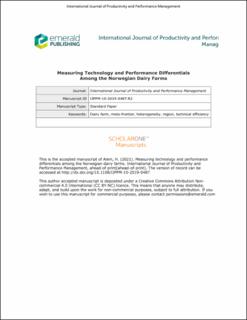| dc.contributor.author | Alem, Habtamu | |
| dc.date.accessioned | 2021-11-15T11:27:22Z | |
| dc.date.available | 2021-11-15T11:27:22Z | |
| dc.date.created | 2021-05-06T10:44:24Z | |
| dc.date.issued | 2021-04-30 | |
| dc.identifier.citation | Alem, H. (2021), "Measuring technology and performance differentials among the Norwegian dairy farms", International Journal of Productivity and Performance Management, Vol. ahead-of-print No. ahead-of-print | en_US |
| dc.identifier.issn | 1741-0401 | |
| dc.identifier.uri | https://hdl.handle.net/11250/2829553 | |
| dc.description.abstract | Purpose The study measures the technology gap and performance of the Norwegian dairy farms accounting for farm heterogeneity. Design/methodology/approach The analysis was based on a meta-frontier and unbalanced farm-level panel data for 1991–2014 from 417 Norwegian farms specialized in dairy production in five regions of Norway. Findings The result of the analysis provides empirical evidence of regional differences in technical efficiencies, technological gap ratios (TGRs) and input use. Consequently, the paper provides some insights into policies to increase the efficiency of dairy production in the country across all regions. Research limitations/implications The author used a meta-frontier approach for modeling regional differences based on a single-output production function specification. This approach has commonly been used in the economics literature since Battese et al. (2004). To get more informative and useful results, it would be necessary to repeat the analysis within terms of multiple input-output frameworks using, for instance, the input distance function approach. Moreover, the author estimated the meta-frontier using the non-parametric approach, thus it is also a need for further analysis if the values are different by estimating using a parametric approach. Practical implications One implication for farmers (and their advisers) is that dairy farms in all regions used available technology in the area sub-optimally. Thus, those lagging the best-performing farms need to look at the way the best-performing farmers are operating. Policymakers might reduce the gap is through training, including sharing information about relevant technologies from one area to another, provided that the technologies being shared fit the working environment of the lagging area. Moreover, some of the dairy technologies they use may not fit other regions, suggesting that agricultural policies that aim to encourage efficient dairy production, such as innovation of improved technology (like breeding, bull selection and improved feed varieties) through research and development, need to account the environmental differences between regions. Social implications For both taxpayers and consumers, one implication is that the contributions they pay that go to subsidize dairy farmers appear to bring some benefits in terms of more efficient milk production that, in turn, increases the supply of some foods so possibly making food prices more affordable. Originality/value The paper contributes to the literature in several ways. In contrast to Battese et al. (2004), the author accounts for farm-level performance differences by applying the model devised by Greene (2005), thus may serve as a model for future studies at more local levels or of other industries. Moreover, the author is fortunate to able to use a large level farm-level panel data from 1991 to 2014. | en_US |
| dc.language.iso | eng | en_US |
| dc.publisher | Emerald Publishing Limited | en_US |
| dc.rights | Attribution-NonCommercial-NoDerivatives 4.0 Internasjonal | * |
| dc.rights.uri | http://creativecommons.org/licenses/by-nc-nd/4.0/deed.no | * |
| dc.title | Measuring technology and performance differentials among the Norwegian dairy farms | en_US |
| dc.type | Peer reviewed | en_US |
| dc.type | Journal article | en_US |
| dc.description.version | acceptedVersion | en_US |
| dc.rights.holder | © 2021, Emerald Publishing Limited | en_US |
| dc.source.journal | International Journal of Productivity and Performance Management | en_US |
| dc.identifier.doi | 10.1108/IJPPM-10-2019-0487 | |
| dc.identifier.cristin | 1908396 | |
| dc.relation.project | EC/H2020/696295 | en_US |
| dc.relation.project | Norges forskningsråd: 299289 | en_US |
| cristin.ispublished | true | |
| cristin.fulltext | postprint | |
| cristin.qualitycode | 1 | |

